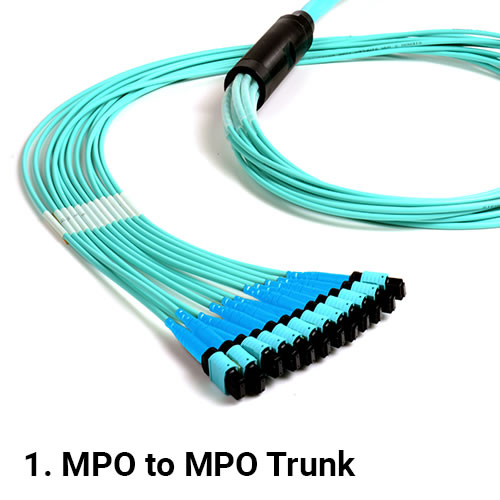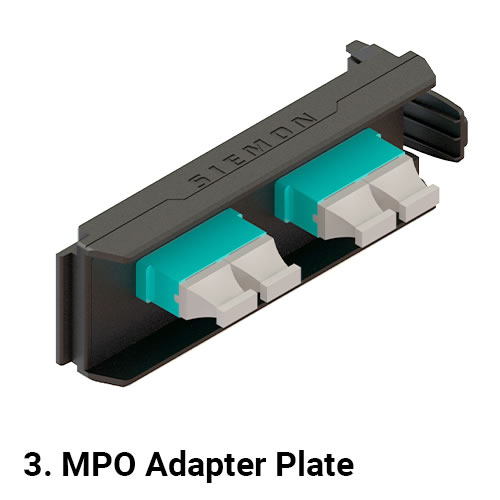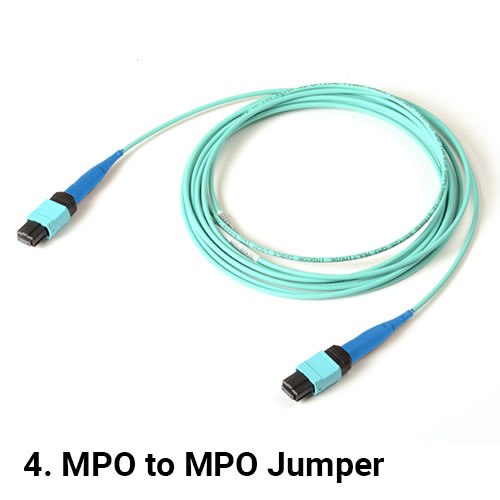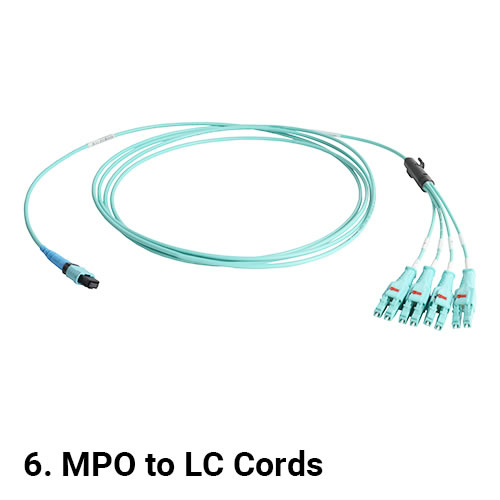Why use Plug and Play Fiber Optic Cabling?
Filed under: Fiber
Comments: Comments Off on Why use Plug and Play Fiber Optic Cabling?

Plug and Play is a term that has been used to describe a product or solution that works seamlessly when the specific components are connected or plugged together. These words were first used as a feature of a computer system by which peripherals were automatically detected and configured by the operating system. The term has been readily adopted by the cabling industry to describe fiber optic structured cabling links used in the data center and links connecting into the data center space. So what is Plug and Play cabling?
Plug and Play fiber optic cabling contains six basic components that are interchangeable and connect together to make a link. They are: 1. MPO-to-MPO trunk 2. MPO-to-LC cassette 3. MPO adapter plate 4. MPO-to-MPO jumper 5. LC-to-LC jumper and 6. MPO-to-LC equipment cord. The main component of Plug and Play is the MPO-to-MPO trunk which connects together the other five parts that will ultimately connect into the computing equipment. See figure #1.
Figure #1






All computing equipment has transceivers or optics that the fiber optic cabling plugs into to complete the connection. There are many types of transceivers or optics available and new types are being released every year. As these new optics are released into the market different types of cabling and connectors are required to make a proper working connection. Another consideration is what type of fiber will be needed in the link – either multimode or singlemode. As these two types of fiber cannot be connected together in a Plug and Play link one needs to be chosen. General parameters of speed and distance help to choose which type of fiber to use. OM4 multimode fiber is typically used for up to 100Gb/s speeds at distances up to 100 meters, while singlemode fiber is used for speeds and distances above 100Gb/s and 100 meters.
Once the fiber type is determined, next is what type of optics will be connected on each end of the link. There are two basic optic types: duplex or parallel. Duplex optics utilize two fibers with one fiber transmitting and one fiber receiving with LC connectors being the most common duplex connector. Parallel optics use eight or sixteen fibers with four or eight fibers transmitting and four or eight fibers receiving with an MPO connector. This is where the Plug and Play link shows its value in that it can support both duplex and parallel optics in a link. As computing equipment refreshes and different optics are used, having the ability to connect them into the existing MPO-to-MPO trunk saves time, labor and money in moves, adds and changes.
A typical duplex Plug and Play deployment has an MPO-to-MPO trunk with MPO to LC cassettes on each end. From the MPO-to-LC cassettes LC jumpers plug into the front of the cassettes and then into the duplex optics as shown in figure #2.
Figure #2

A cross-connect can be added into the link to best serve medium to large data centers with different generations of computing equipment. With a cross-connect design, an active port from a spine, director or core switch can be moved out into the data center space one port at a time. This design helps minimize unused ports so as not to have active ports where they aren’t being utilized or plugged into as shown in figure #3.
Figure #3

The above two Plug and Play links are for duplex or LC optics like the 400GBASE-FR4. With the release of 400G and the soon to be released 800G speeds, singlemode parallel optics are a popular choice for distances of 500 meters or less. This optic is known as 400GBASE-DR4. This 500 meter distance limitation fits into most data center applications.
A typical parallel Plug and Play deployment has an MPO-to-MPO trunk with MPO adapter plates on each end. From the MPO adapter plates MPO jumpers plug into the front of the adapter plates and then into the parallel optics as shown in figure #4. A cross-connect can also be used with parallel optics as it does with duplex optics. Note that customers can readily migrate from duplex applications to parallel applications by removing the MPO-to-LC cassettes and replacing them with MPO adapter plates. This migration is why it’s recommended to use Base-8 components verse Base-12 as the Base-8 option provides use of all fibers in the MPO-to-MPO trunk after the conversion from duplex to parallel links.
Figure #4

With Plug and Play there is an option to breakout one parallel optic into four duplex optics. For instance, this happens with both Ethernet and Fibre Channel links like 100 Gb/s to 4x 25 Gb/s and 128 Gb/s to 4x 32 Gb/s, respectively. Again, the main component is the MPO-to-MPO trunk. On both ends is the MPO adapter plate. On one end is an MPO jumper into the parallel optic and on the other end is an MPO-to-LC equipment cord with four LC connectors plugging into the four duplex optics as shown in figure #5. Plug and Play supports three types of links: duplex-to-duplex, parallel-to-parallel and parallel-to-duplex.
Figure #5

As mentioned at the beginning, Plug and Play has six basic components. The MPO-to-MPO trunks are built to the length of the application and are available in fiber counts of 8 to 144. It is recommended that the MPO trunks are built as Base-8 with Method B polarity to best support duplex and parallel optics. It is also recommended that the MPO trunks have pinned (pinned) connectors so they can plug into MPO jumpers which are non-pinned (unpinned). The MPO-to-LC cassettes that plug into the MPO trunk are also non-pinned (unpinned) to plug into the MPO trunk and built with Type B polarity. The MPO jumpers as non-pinned (unpinned) can also directly connect two parallel optics using Type B polarity. LC to LC jumpers are type A-to-B and will plug together two duplex optics. The MPO-to-LC cords are also non-pinned (unpinned) and will plug into the MPO trunk and breakout a parallel optic into four duplex LC connections.
Once the Plug and Play cabling components are selected, adding new links is easily repeated by stocking basic hardware components like enclosures, MPO-to-LC cassettes, MPO adapter plates, MPO and LC jumpers. As the MPO trunk lengths can change depending on the distance of the link they can be purchased with quick ship programs.
